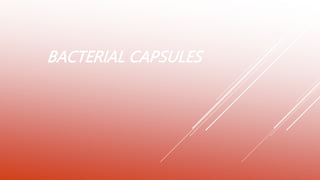
Bacterial Capsules: Introduction, Examples and Functions
- 2. TOPIC TO COVER ….. o INTRODUCTION TO CAPSULES o COMPOSITION o EXAMPLES OF SOME BACTERIA S. pneumonia E. coli P. mirabilis B. anthracis o FUNCTION OF CAPSULE
- 3. CAPSULES • Capsules are the outermost structures of bacterial and fungal cells. • These are physically associated with the cell surface and cannot be readily washed off. • Thickness ≈ 0.1 to 10 microns. • Capsules have a sufficient size and are readily visible, referred as capsules . • Whereas many microorganisms produce a variety of extracellular materials they may be too thin or soluble in medium and called as slime layer .
- 4. . Capsulated cells of pathogenic bacteria are usually more virulent than the cells without capsules. When grown on the agar media, encapsulated bacteria usually form colonies with the distant appearance and morphology . In some bacteria, the colonies of encapsulated bacteria are referred as “smooth colonies “ and those which are unencapsulated are the “rough colonies “ . Some strains fail to produce the polysaccharide capsular material are “ Avirulent “ and those which produce are called as “ Virulent “. Eg. of avirulent : S. pneumoniae of virulent : B. anthracis
- 5. COMPOSITION OF CAPSULES Capsules is a gelatinous polymer made up of either polysaccharide or polypeptide or both. Capsules are usually polymers of simple sugars : mucus polysaccharide – colanic acid or M antigen . exception : B. anthracis –poly glutamic acid (PGA). Capsules can be detected by light and electron microscopy after staining bacteria with dye. By Mordant – cause precipitation of capsular material by metal ions alcohol , acetic acid . India Ink – the capsules is displayed as clear halo between the stained cells and the background . Reaction of capsule with specific antiserum is to enlarge the capsular area soit is visualized under microscope .
- 6. The polysaccharide capsular substance produced by S. pneumonia confers the immunological specificity and are also associated with virulence. 90 distinct capsular serotypes ,each differing in sugar composition and/or linkages have been recognized and structures are determined. Type 3 pneumonococcal polyscacharide is composed of : -- glucopyranose and glucuronic acid is alternating β-1,3 and β-1,4 linkage. Synthesis of Type 3 capsular polysaccharides of S. pneumonia requires UDP-glucose (UDP-Glc) and UDP-glucuronic acid (UDP-GlcUA) for the production of 3-β-D-Glc-(1,4)-β- D-Glc-[1]n polymer. The generation of UDP-Glc procced by the conversion of; Glc-6-P to Glc-1-P to UDP-Glc and is mediated by the phosphoglucomutase ( PGM) Glc-1-P- uridylyltransferase respectively. S. pneumoniae CAPSULE
- 7. . Gene encoding both Glc-1-P-uridylyltranferase (cps3U) and for PGM homolog (cps3M) are present in the Type-3 capsule locus, but the genes are not essential for capsule production. Other S. pneumonia serotypes and in other streptococci,enzyme expected for the capsule production are the present in the capsule locus and encoded by the genes. Eg. Type-14 locus lacks genes for the synthesis of UDP-glucose ,UDP-galactose and UDP-N-acetylglucosamine , precursor of type 14 polysaccharide. In other strains of S.pneumonia and S.pyogenes the sugar or other intermediate is important component of teichoic acid or peptidoglycan and cells uses existing cellular pools of these for synthesis of capsular polysaccharide.
- 8. E. coli CAPSULE A number of strains of E.coli produce capsular polysaccharide called as K antigen . They are structurally diverse and give rise to serological specificity. There are 70 recognized K antigen in E.coli. the K antigen are placed in either Capsular Group I (heat stable) or Capsular Group II (temperature stable). Eg. K30antigen if E.coli is member of Group I and K5 of Group II. The Group II K antigen are characterized by acidic components such as 2-keto-3-deoxy-D-mannooctulonic acid,N-acetylneurominic acid (sialic acid ),N-acetylmamosaminouronic acid .
- 9. . The k5 polysaccharide is nonimmunogenic and strains of E.coli expressing this capsule are quite virulent. The capsular polysaccharide 17-kb multi-gene cluster encodes the proteins requires for the synthesis, activation, and assembly of K antigen. Three distinct regions have been identified in this gene cluster. Central region or region 3 – neu genes (polysaccharide synthesis) Region 1and 3 -kps genes (polymer assembly and transport ) E.coli K-12 and other enteric bacteria produce a slime polysaccharide , colonic acid , called M antigen . The genes rcsAk12 and rcsAK30 – expression of colanic acid synthesis .
- 10. P. mirabilis CAPSULES P. mirabilis produce an acidic capsular polysaccharide . It is of high MW of branched trisaccharide units composed of 2- acetamido-2-deoxy-D-glucose(N-acetyl-D-glucosamine) , 2- acetamido-2,6-dideoxy-L-galactose (N-acetyl-L-fucosamine) and D- glucuronic acid . The acidic nature of this polysaccharide play a role in urinary calculi (stone) formation . The process is initiated by the a minute focus of solid matter that grows continually larger as chemical crystals that precipitate from urine adhering to it.
- 11. The B.anthracis capsules is a polypeptide of γ-D-glutamyl subunits originally thought to be produce only in vivo during infection but later in culture if access of CO2 or bicarbonate is present. High MW peptide capsules produced by – Yersinia pestis and Bacillus anthracis. Other species of bacilli (eg. B.subtilis) produce a polypeptide capsule containing a mixture of D- and L-glutamic acid sub units. B. anthracis CAPSULES
- 13. FUNCTION OF CAPSULES A capsular layer of extracellular polysaccharide material can enclose many bacteria into a biofilm and serves many function. The function includes : adhesion ,transmission, resistance to innate host defenses , resistance to host’s adaptive immune response and intracellular survival. 1. Attachment to surfaces. 2. Protection against phagocytic engulfment. 3. Protecting the cell wall against attack by various kinds of antibacterial agents, lysozyme, bacteriophages, etc . 4. Protection against osmotic stress. 5. Protection from chemical present in environment eg. Detergents 6. Protection against harsh environmental condition.
- 14. Reference : MOAT , FOSTER AND SPECTOR Microbial physiology 4 Edition .
- 15. THANK YOU…